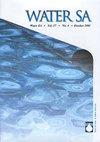On the Flow Characteristics (FC) method for estimating sustainable borehole yield
IF 1
4区 环境科学与生态学
Q4 WATER RESOURCES
引用次数: 0
Abstract
Flow Characteristics (FC) is one of the few methods developed for predicting long-term sustainable borehole yield of single wells in typical fractured rock aquifers. The FC method uses drawdown derivatives and subjective information on no-flow boundaries to estimate a sustainable borehole yield that should not cause the water level to drop below the main water strike (fracture) during long-term operations. Since its development, the FC method has been widely applied in many research and consulting projects. Two decades after its development, a review of its technical capabilities and limitations is necessary to enhance understanding among groundwater practitioners while building a platform for further improvements. The main strength of the method is its simplicity of use, its ability to protect the main water strike/fracture, and its lower susceptibility to the influence of aquifer heterogeneities because it does not require the input of aquifer storativity and transmissivity. The FC method also caters to the negative influence of impermeable boundaries, thereby enabling planning for different low-yield-causing scenarios. However, the major limitation is in using the subjective closed no-flow boundary without factoring aquifer storativity and the distance of the closed no-flow boundary from the pumping well. Under the influence of the closed no-flow boundary, the water must come from aquifer storage, hence the storativity and the size of the bounded aquifer are very critical parameters. It is therefore incorrect to factor in the influence of the closed no-flow boundary without considering its exact location. This limitation is reflected in the absence of criteria to determine the distance of the closed no-flow boundary from the pumping well for validating the FC results using numerical models. The FC method still needs validation using field operational data; other recommendations for future research are highlighted in the discussion.关于估算可持续井眼产量的流量特性(FC)方法
流量特性(FC)是为数不多的几种预测典型裂隙岩含水层中单井长期可持续井眼产水量的方法之一。 FC 方法使用缩减导数和无流边界的主观信息来估算长期作业期间不应导致水位下降到主水流(裂缝)以下的可持续井眼产水量。自开发以来,FC 方法已在许多研究和咨询项目中得到广泛应用。在其发展 20 年之后,有必要对其技术能力和局限性进行审查,以加强地下水从业人员对其的了解,同时为进一步改进建立一个平台。该方法的主要优点是使用简单,能够保护主要水流走向/断裂,而且由于不需要输入含水层的储量和渗透率,因此不易受含水层异质性的影响。FC 方法还能应对不透水边界的负面影响,从而对不同的低产情况进行规划。然而,该方法的主要局限在于使用主观的封闭式无流边界,而没有考虑含水层的储量和封闭式无流边界与抽水井的距离。在封闭式无流量边界的影响下,水量必须来自含水层的储量,因此,含水层的储量和边界含水层的大小是非常关键的参数。 因此,不考虑封闭式无流边界的确切位置而将其影响考虑在内是不正确的。这一局限性体现在缺乏确定封闭式无流边界与抽水井距离的标准,以便利用数值模型验证 FC 结果。FC 方法仍需使用现场运行数据进行验证;讨论中还强调了其他未来研究建议。
本文章由计算机程序翻译,如有差异,请以英文原文为准。
求助全文
约1分钟内获得全文
求助全文
来源期刊

Water SA
环境科学-水资源
CiteScore
2.80
自引率
6.70%
发文量
46
审稿时长
18-36 weeks
期刊介绍:
WaterSA publishes refereed, original work in all branches of water science, technology and engineering. This includes water resources development; the hydrological cycle; surface hydrology; geohydrology and hydrometeorology; limnology; salinisation; treatment and management of municipal and industrial water and wastewater; treatment and disposal of sewage sludge; environmental pollution control; water quality and treatment; aquaculture in terms of its impact on the water resource; agricultural water science; etc.
Water SA is the WRC’s accredited scientific journal which contains original research articles and review articles on all aspects of water science, technology, engineering and policy. Water SA has been in publication since 1975 and includes articles from both local and international authors. The journal is issued quarterly (4 editions per year).
 求助内容:
求助内容: 应助结果提醒方式:
应助结果提醒方式:


